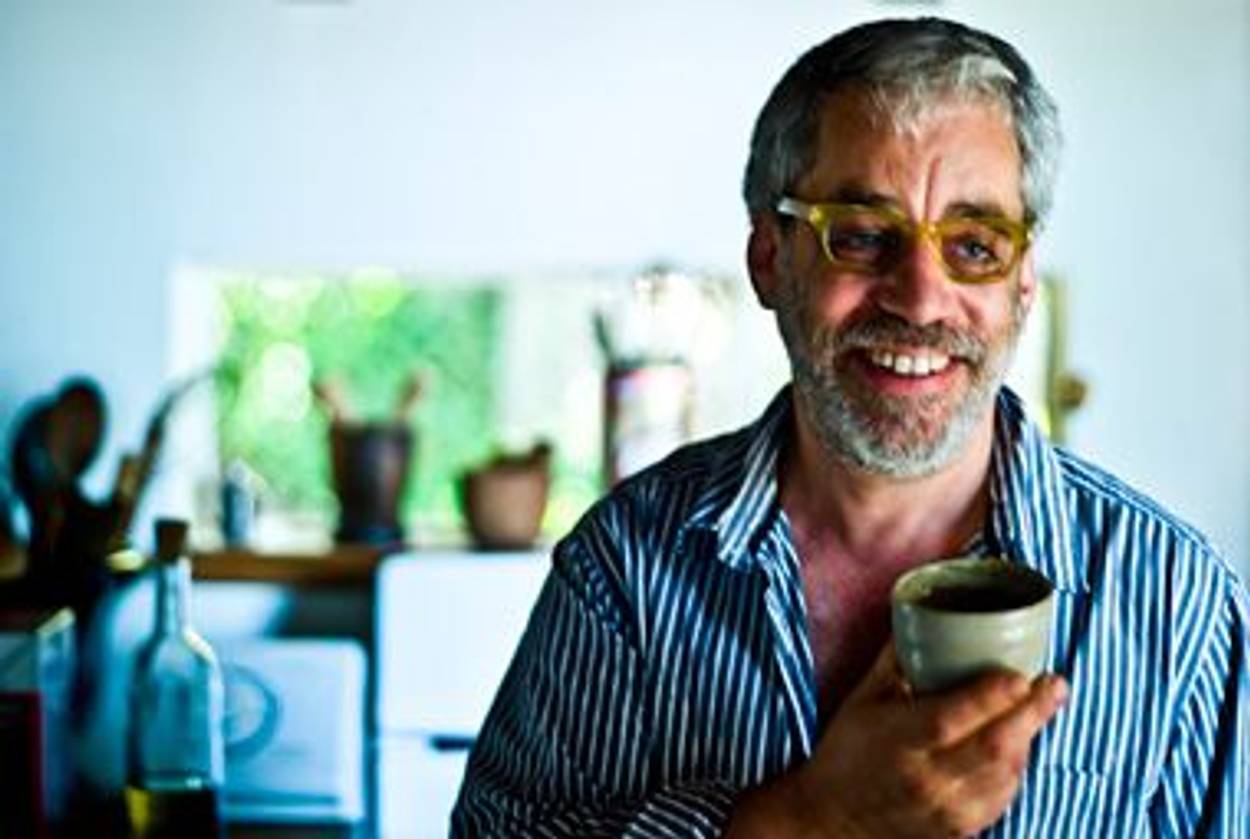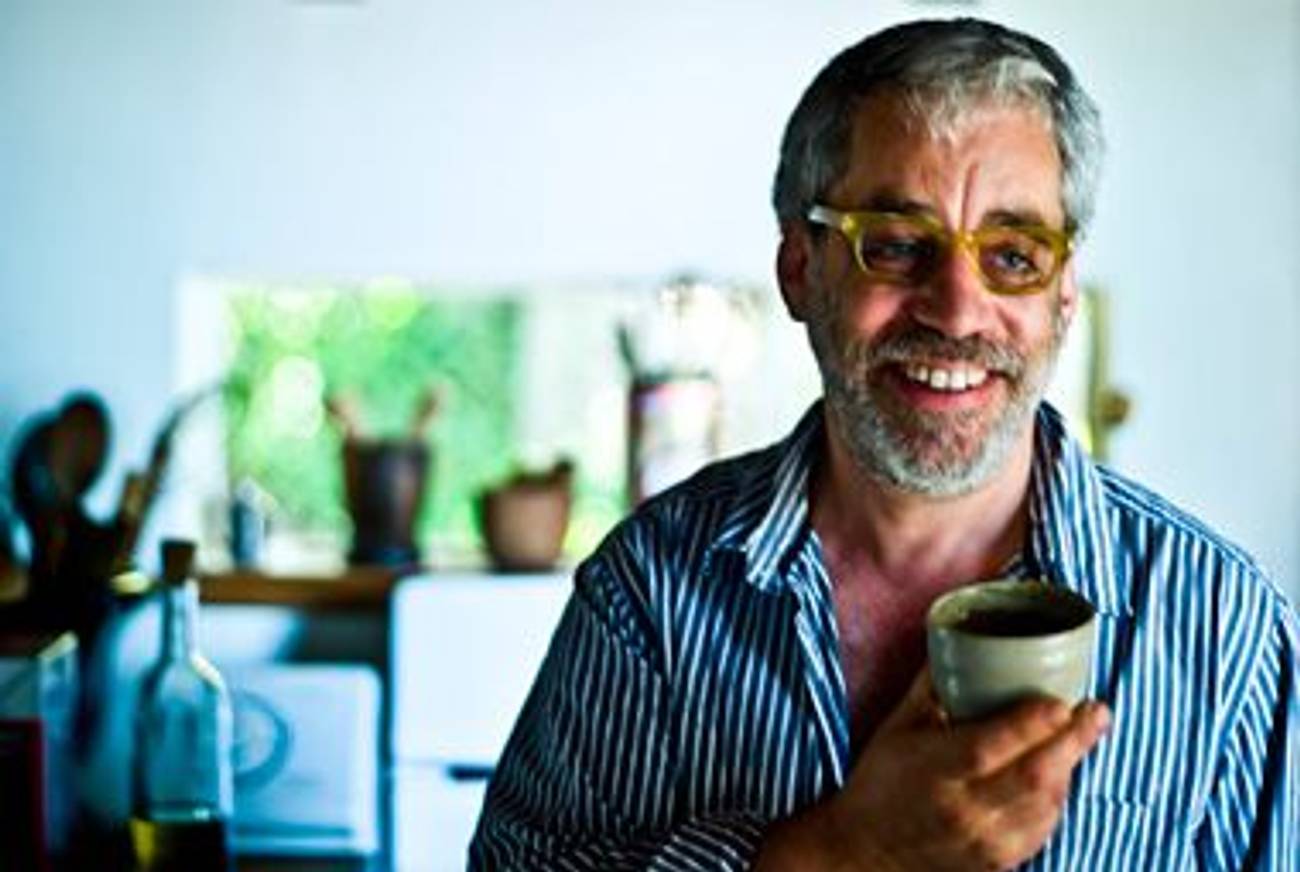New Kid
David Tanis, Chez Panisse chef, cookbook author, and now food columnist for the New York Times, is best known for his seasonal cuisine. But this Midwestern-born chef cites Jewish food as his culinary roots.




David Tanis is known for many things: longtime chef at the acclaimed Chez Panisse in Berkeley, Calif.; author of two cookbooks, A Platter of Figs and Heart of the Artichoke; and, as of last week, food columnist for the New York Times. Being Jewish isn’t one of them.
I met Tanis, 58, for the first time on a recent visit to Berkeley, and he told me about his childhood in Dayton, Ohio, and how he considers Jewish food his culinary roots. “Our family was kind of a funny family,” he said. “We always did Friday nights, but it usually wasn’t at our house,” eating instead at their good friends’, whom Tanis called Aunt Edith and Uncle Marvin. “We didn’t do the whole nine yards, but we did matzoh balls to chremsel. I was totally into it.” He considers matzoh brie a “primal craving” and spoke about his love for herring (his new apartment in New York is a block away from Russ & Daughters, he notes). In Dayton, Tanis attended Hebrew school and had a bar mitzvah, but then, “I ran away into the large wide world,” he said.
His first stop: Deep Springs College, an all-male school in the California desert. Later he traveled to Europe, North Africa, Asia, Mexico, and South America. “Food and travel go together for me,” he said. “Eating is like learning a language.” Wherever he travels, Tanis seeks out the local markets and a home base with a kitchen where he can test the culinary waters.
Tanis has been at Chez Panisse, the pioneering Alice Waters’ restaurant, on and off since the early 1980s. During one of his traveling stints to Paris he and his partner, Randal Breski, found a 17th-century apartment on the Left Bank, and he struck an enviable arrangement with Waters: For the past decade he has split his time, working half the year at Chez Panisse and the other half living in Paris, where he has run a small private dining club that he and Breski dubbed Aux Chiens Lunatique, At the Crazy Dogs’ Place, after their dogs, Arturo and Ajax. But this schedule will, in part, be coming to an end; in October he will leave his post at Chez Panisse to move to New York and focus on his writing.
When I met with Tanis last month, lucky for me, he was still behind the Chez Panisse stove. The restaurant features a set menu—you eat what is prepared for you—and this meal was one of the best I have ever tasted. The dishes had all the essential ingredients, but none too many. The first course, salmon à la nage, consisted of a pavet of sweet wild Pacific salmon, the kind that is available for only a few weeks in the late spring. Tanis served it in a court bouillon, a light vegetable broth, one that the former Chez Panisse chef Paul Bertolli had introduced, but to which Tanis added his own spin with Asian ingredients like star anise and lemongrass. He poached the fish in the broth and served it with a melted ginger-cilantro butter, and the result was refreshingly delicious. For dessert we ate lemon verbena ice cream with rose petals coated in egg white and dipped in mint.
In his books, as well as in his first columns for the Times, you sense what one of Tanis’ friends calls his “elusive” presence. His writing is beautiful and modest; he rarely uses the word “I.” Still, he carries you on incredible journeys, with his food providing the way.
Right now, Tanis is focused on salmon. “This year’s fish has been incredible,” Tanis said, “with real sweetness and an almost velvety texture.” I recently made his salmon recipe and savored it as a main course, with a salad, for a summer dinner. This fish and his lemon verbena ice cream, like so many of David’s dishes, accentuate the sweetness but never distract the purity of the flavors.
Salmon à la Nage With Ginger-Cilantro Butter
Adapted by David Tanis from Chez Panisse Cooking by Paul Bertolli with Alice Waters
4 ½ tablespoons very thinly sliced carrot rounds (1 ½ ounces)
3 tablespoons very thinly sliced celery from the heart (1 ounce)
½ cup very thinly sliced yellow onion rounds (2 ounces)
3 sprigs fresh lemon thyme
2 stems lemon grass, pounded
1 large sprig Italian parsley
½ cup Sauvignon Blanc
1 ½ teaspoons salt
For the herb butter:
4 tablespoons unsalted butter at room temperature
1 small shallot (½ ounce), finely diced
1 inch of fresh ginger, peeled and grated
1 handful cilantro
Zest of ¼ lemon
Pinch of salt and pepper
½ tablespoon thinly sliced chives
Four 4-ounce pieces of salmon, cut 1 inch thick
handful of spinach
1. Prepare the court bouillon by putting the carrots, celery, onion, thyme, lemongrass, and parsley in a non-corrosive pot large enough to hold the salmon pieces side by side with room to spare. Add 3 cups of water, the Sauvignon Blanc, and salt to taste. Bring to a simmer, cover, and cook very slowly for 20 minutes.
2. In the meantime, prepare the herb butter: Mix the butter together with the ginger, lemon, cilantro, salt, and pepper. Set the butter aside in a small bowl and keep it at room temperature.
3. Taste the court bouillon and correct it to your taste for salt. Bring the court bouillon to a bare simmer and add the salmon. If you are using a small pot, the salmon will be submerged and will require about 3 to 4 minutes cooking time. (It should be removed when lightly undercooked in the center. With a small knife, part the filet to check.) Otherwise, gently poach the salmon slices, cut side down, in the hot liquid for about 2 ½ minutes on each side. Do not raise the heat during this time. Transfer the salmon to warm soup bowls and put a dollop of herb butter on each slice. Add the spinach to the hot court bouillon and ladle the liquid with the spinach over the butter and salmon, add some of the vegetables from the pot to each bowl, and serve, sprinkled with the chives.
Yield: 4 servings
Lemon Verbena Honey Ice Cream
Adapted from A Platter of Figs and Other Recipes by David Tanis
2 cups whole milk
1 cup loosely packed lemon verbena leaves
1 cup heavy cream or crème fraîche
¾ to 1 cup honey
6 large organic egg yolks
½ teaspoon salt
1. In a medium stainless steel pan, warm the milk until it comes to a low simmer. Turn off the heat and add the lemon verbena. Let steep, covered, for 15 minutes or so, until the milk has a faint lemon flavor.
2. Strain the milk, discard the verbena, and return the milk to the pan. Add the cream and honey and warm gently.
3 . Meanwhile, beat the egg yolks with the salt in a small bowl. Gradually whisk 1 cup of the warm milk mixture into the yolks to temper them, then add the contents of the bowl to the milk, cream, and honey mixture. Cook gently for 5 minutes or so, stirring diligently, until the mixture thickens slightly, enough to coat the back of a spoon.
4. Strain this thin custard into a large bowl and set aside to cool. Once cool, chill in the refrigerator overnight.
5. Freeze the custard in an ice cream maker according to the manufacturer’s instructions. After churning, transfer the ice cream to the freezer for an hour, then serve (or store it in the freezer and leave it out to temper for 15 minutes before serving).
Yield: about 1 quart
Joan Nathan is Tablet Magazine’s food columnist and the author of 10 cookbooks including King Solomon’s Table: a Culinary Exploration of Jewish Cooking from Around the World.